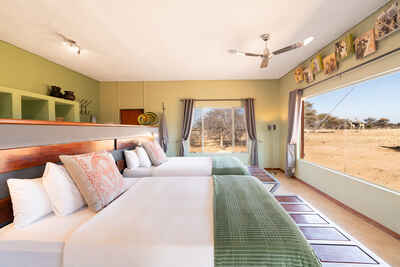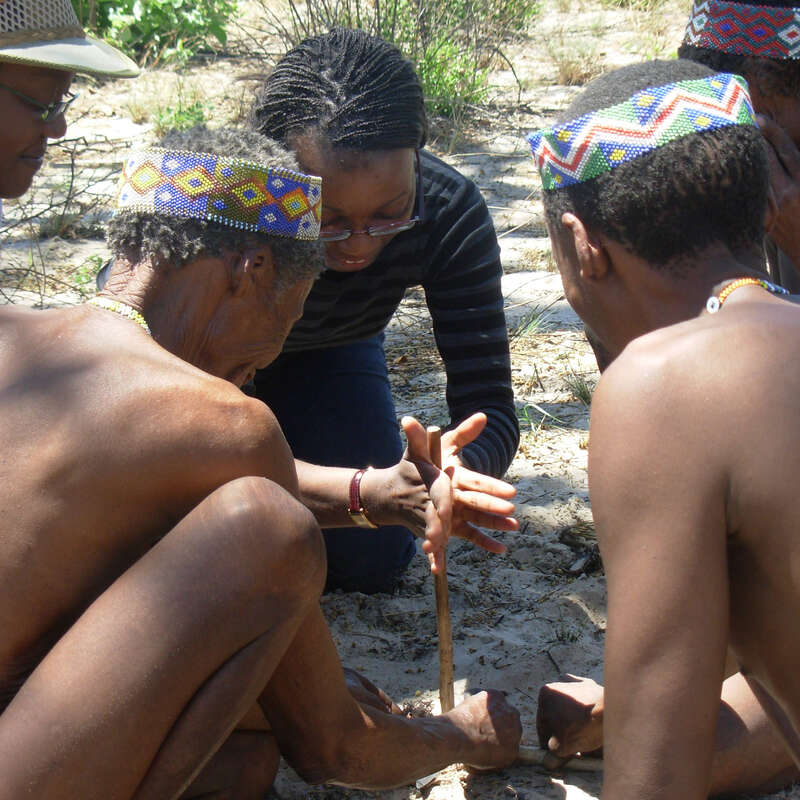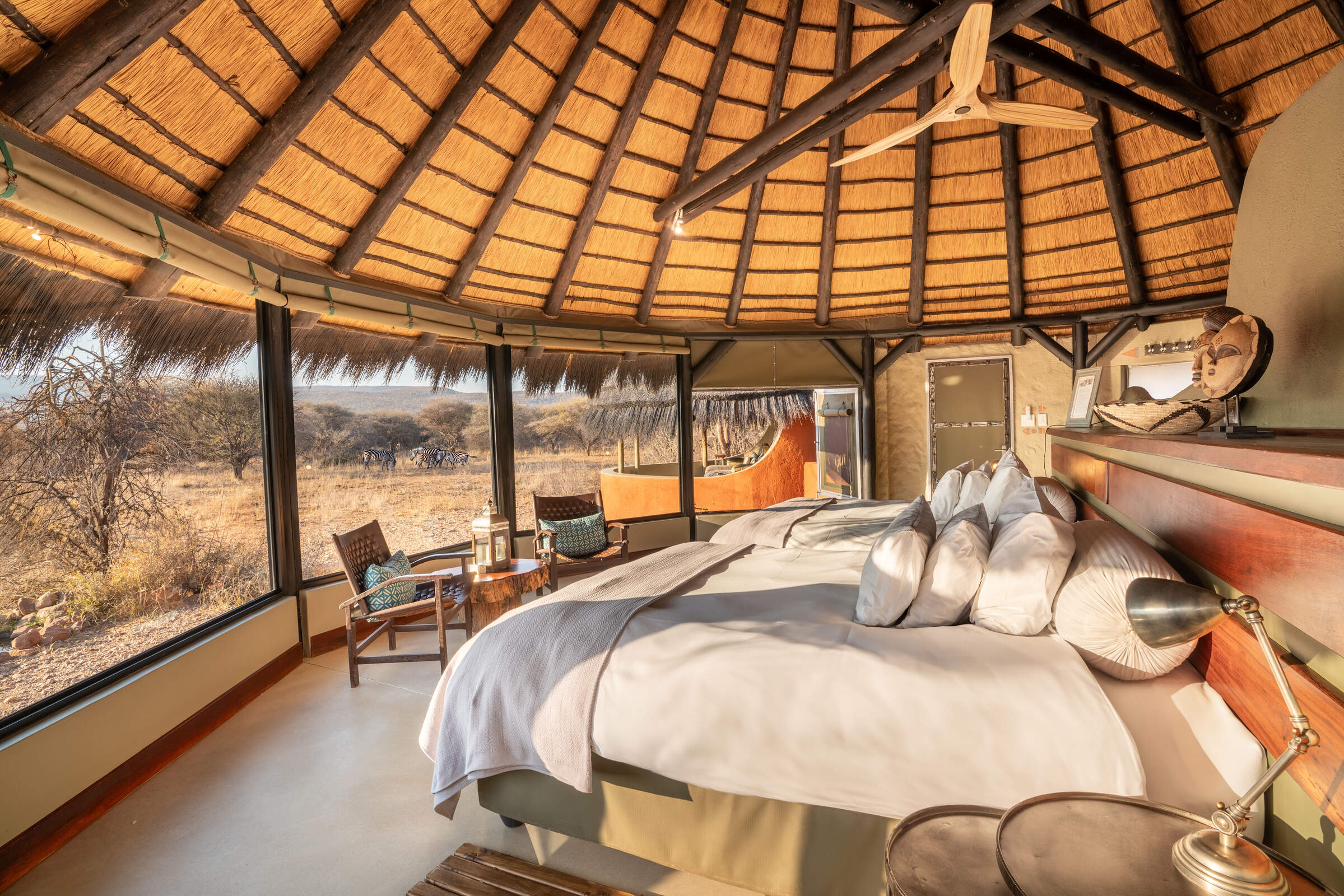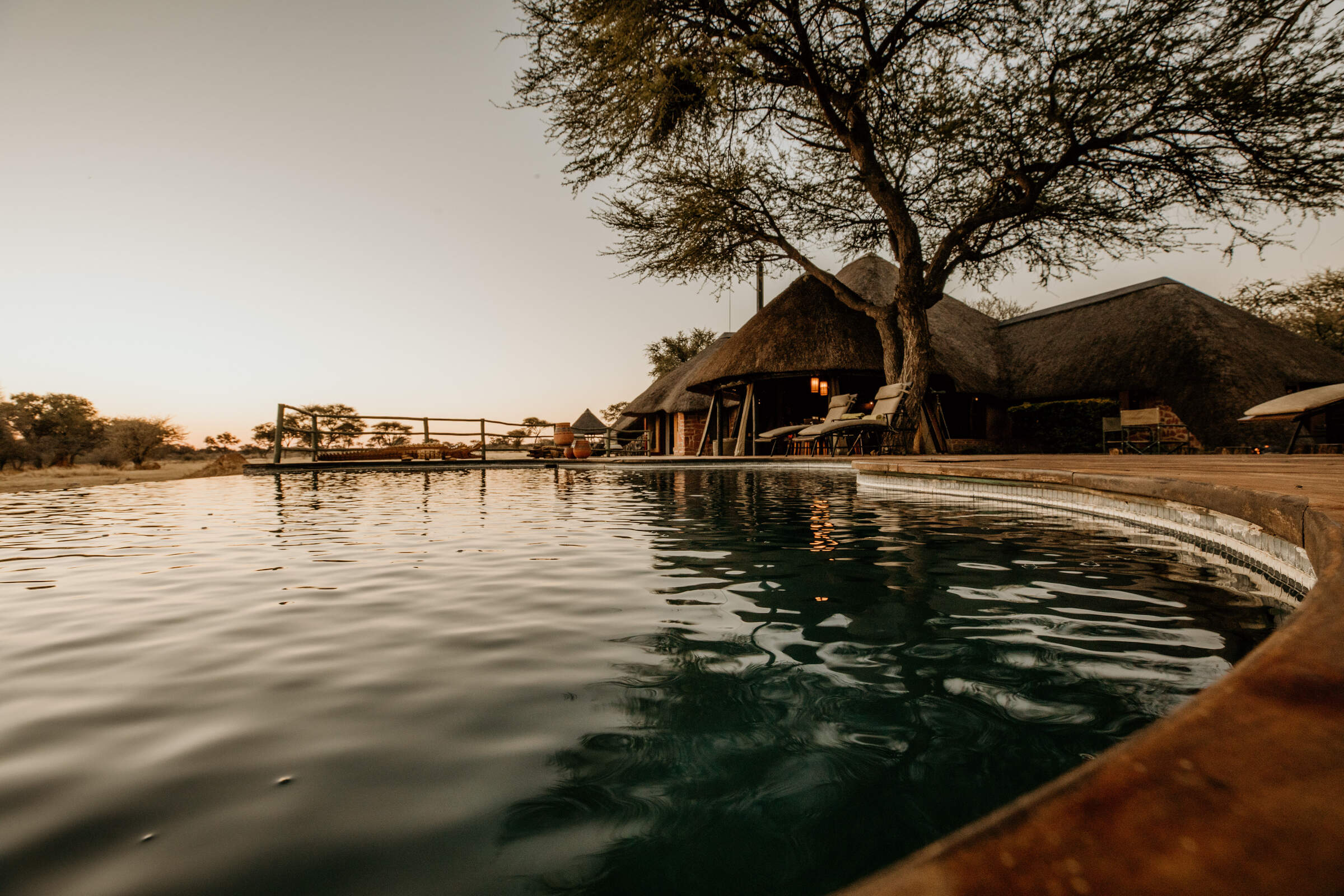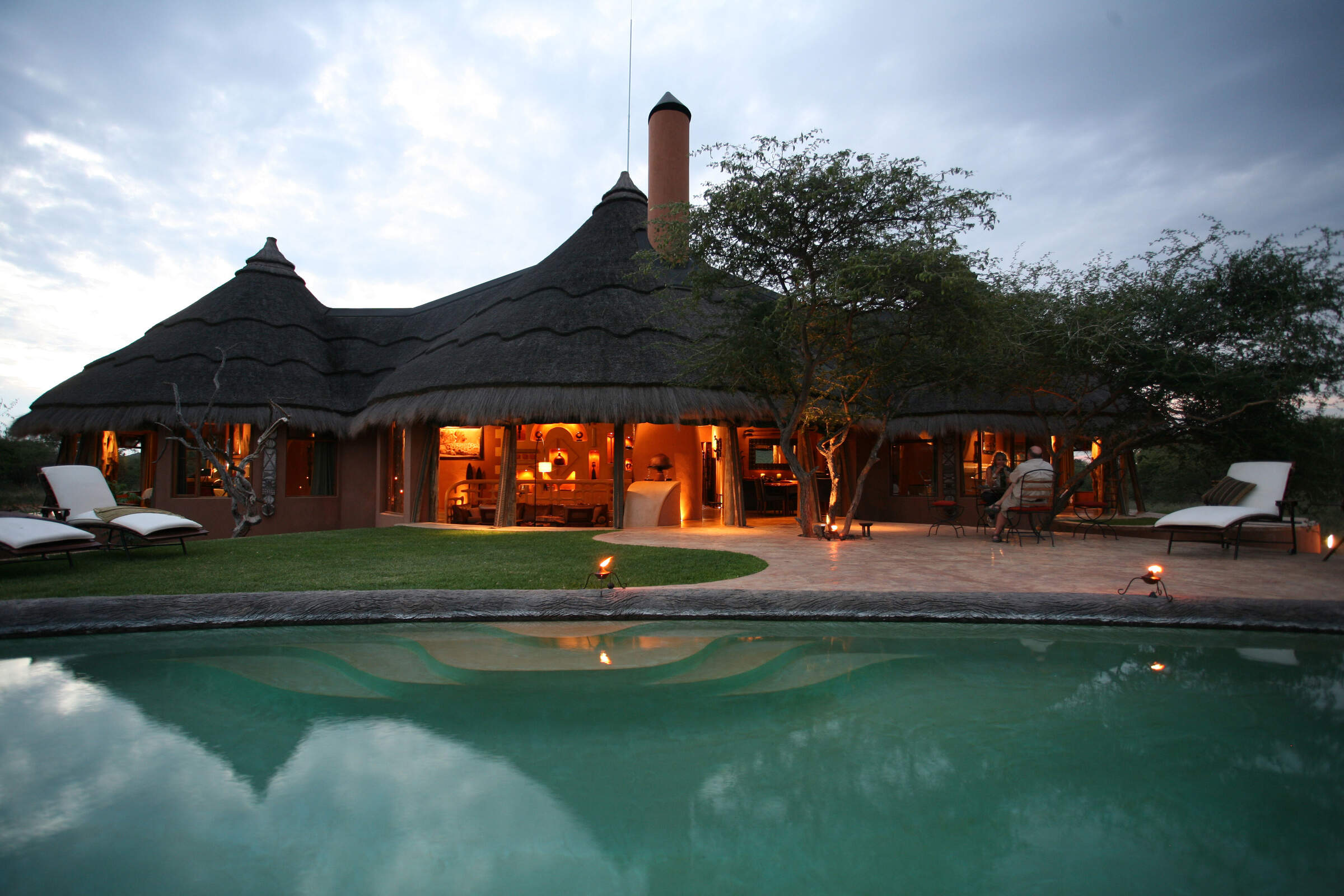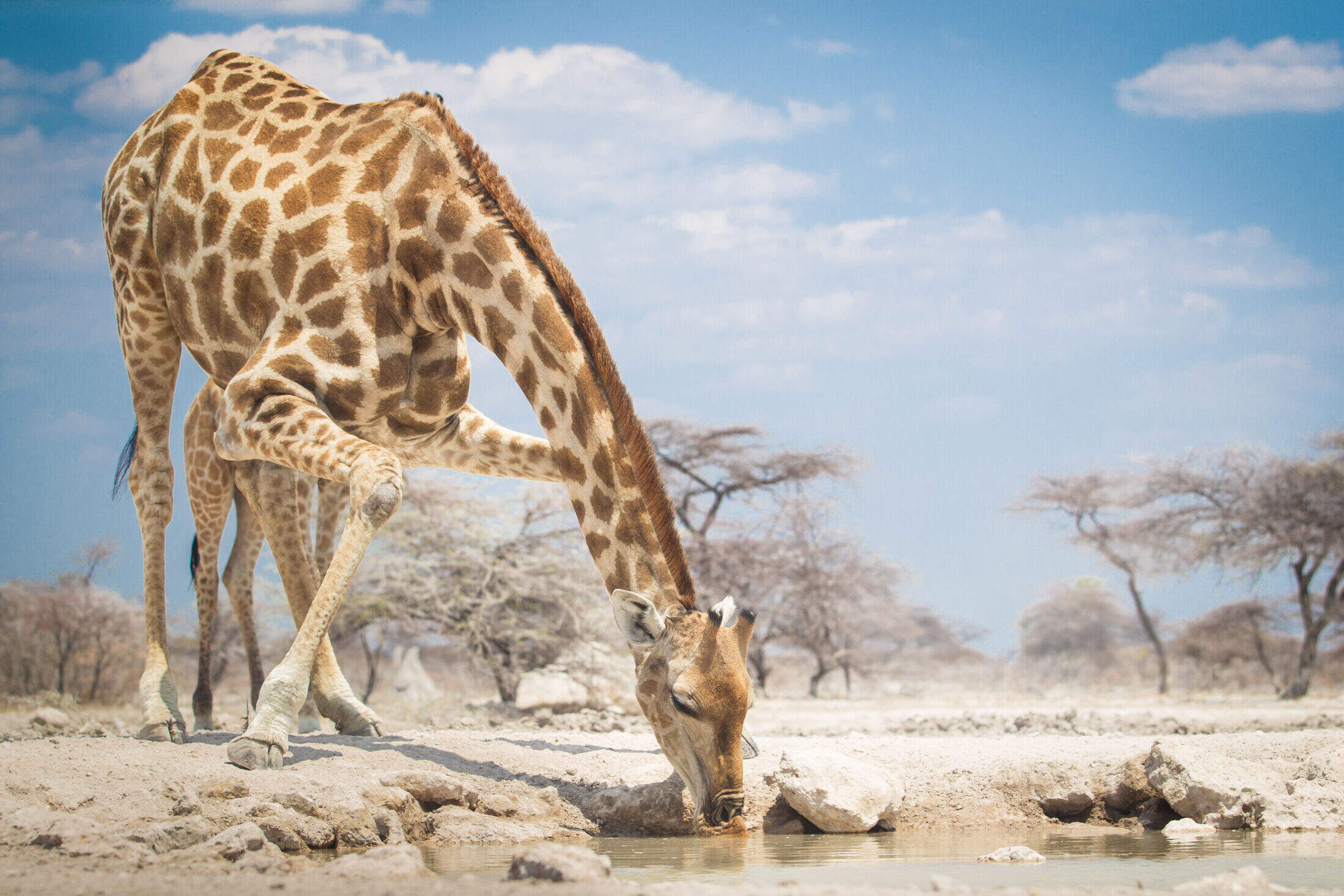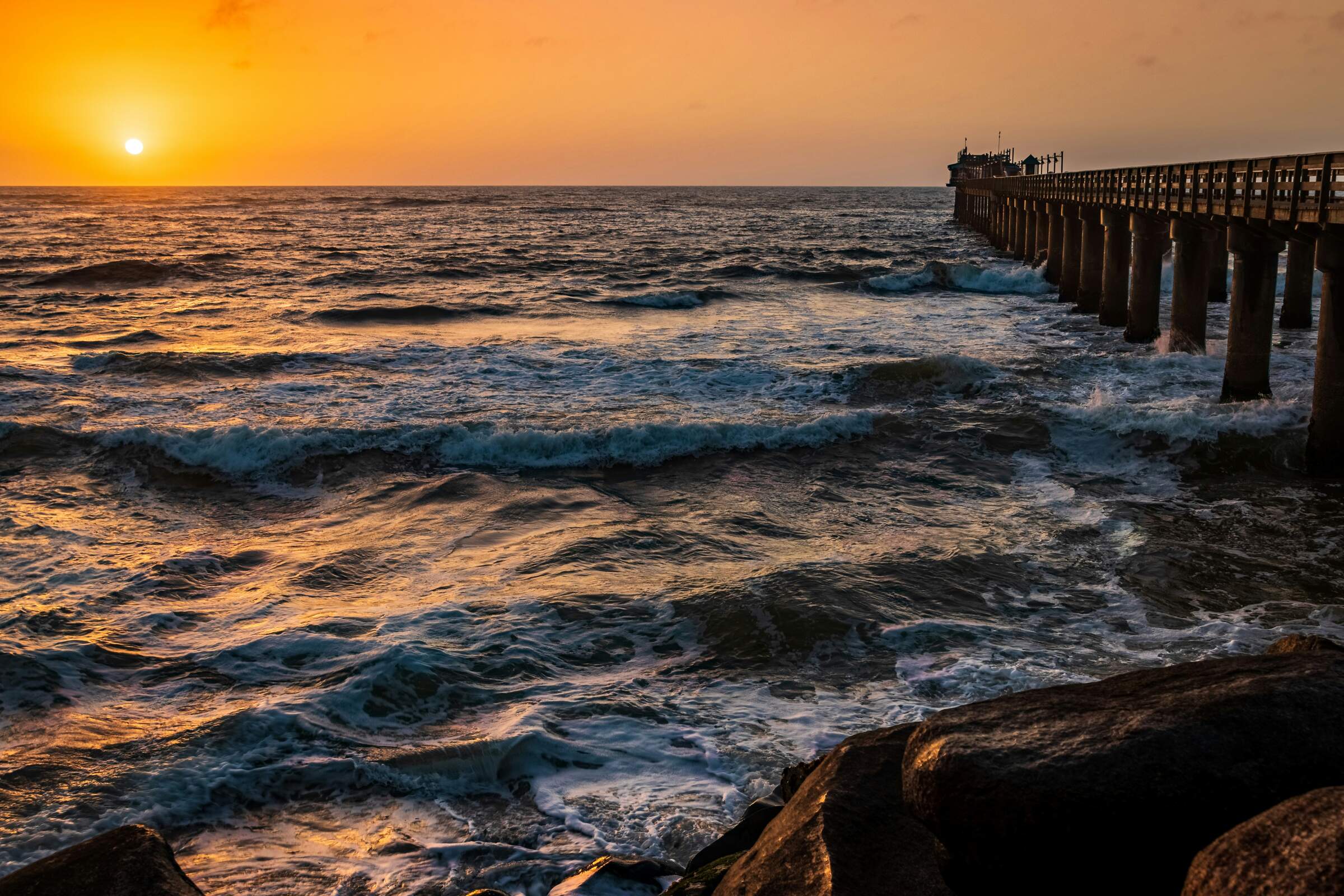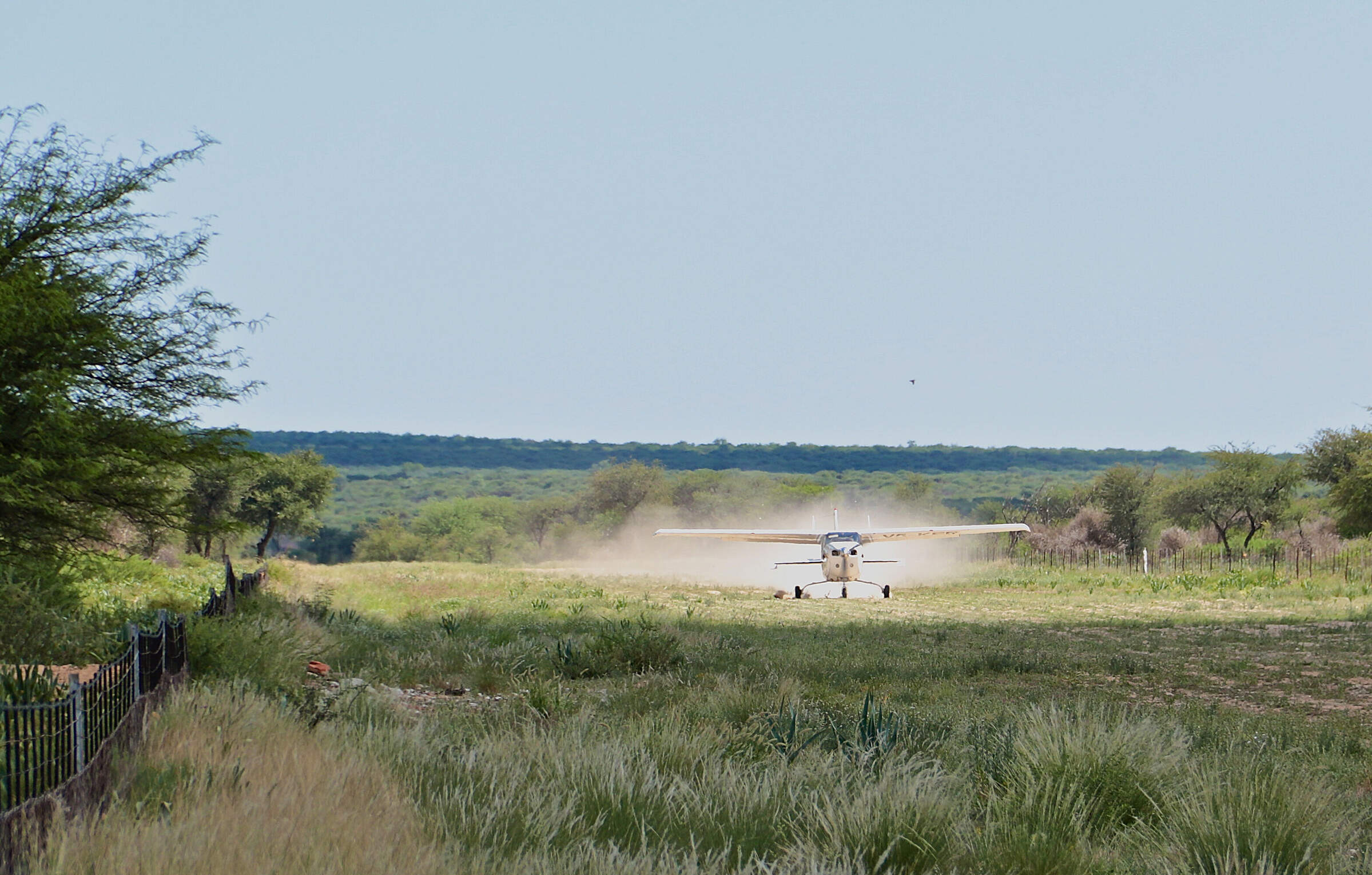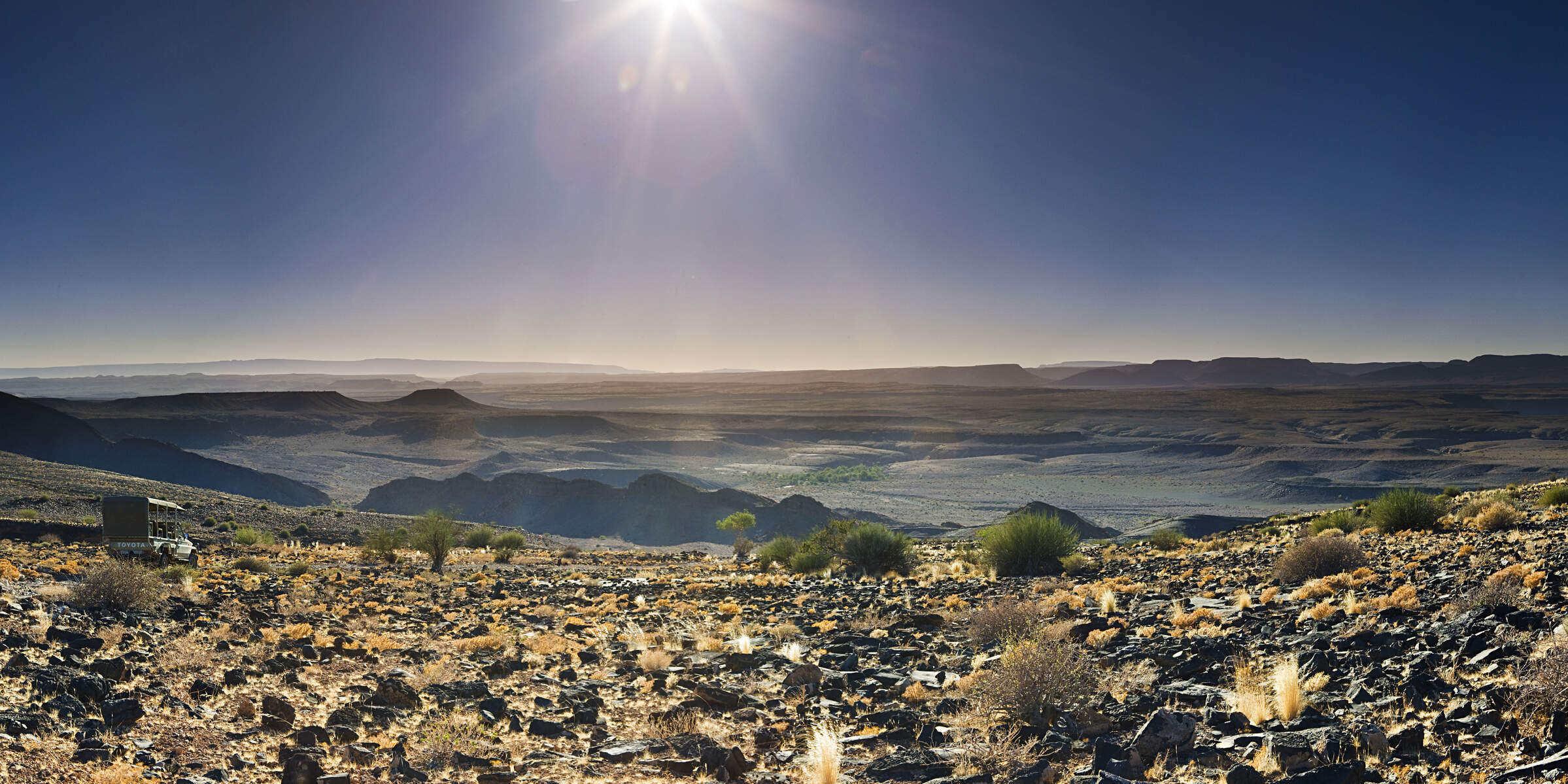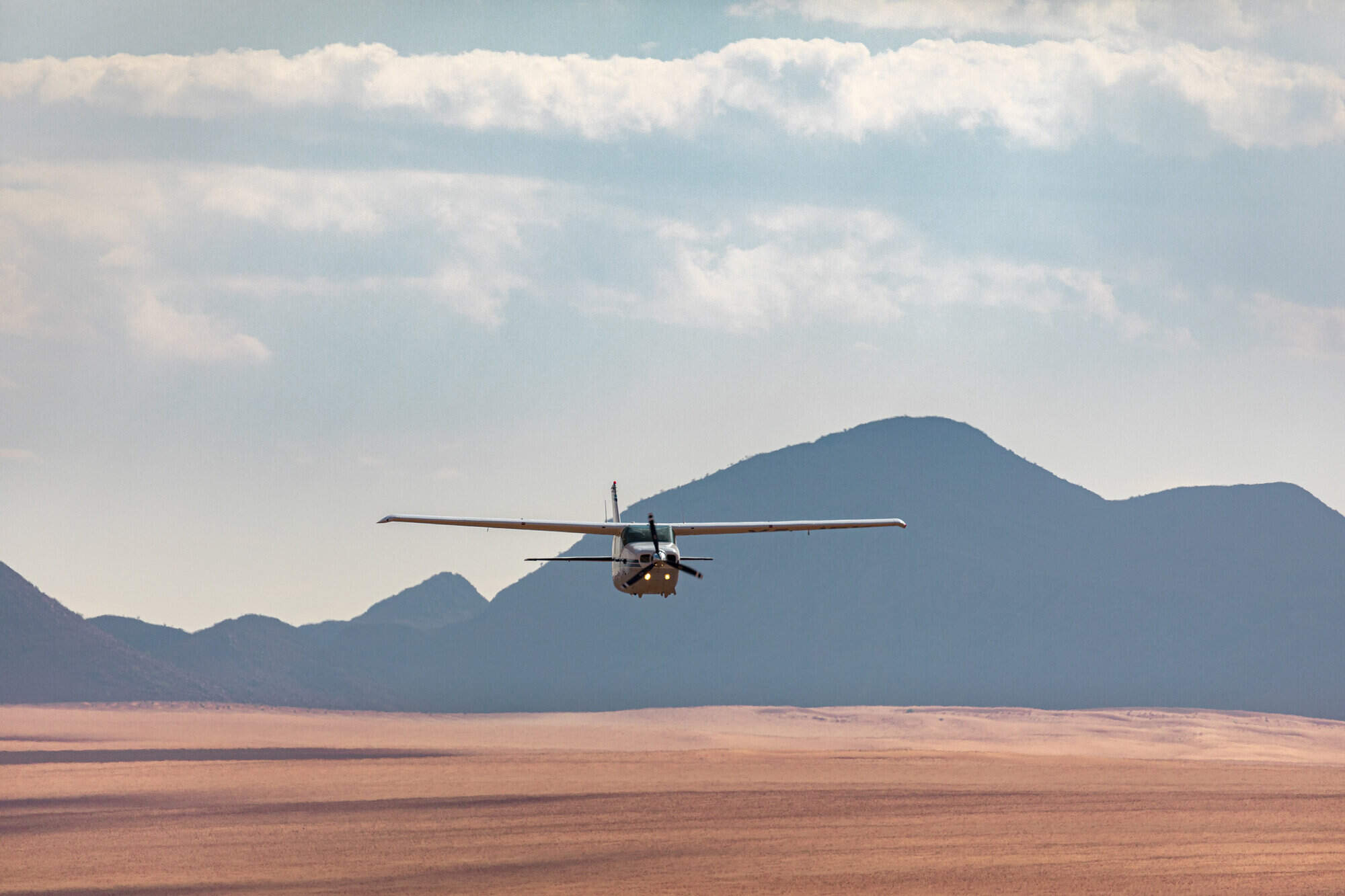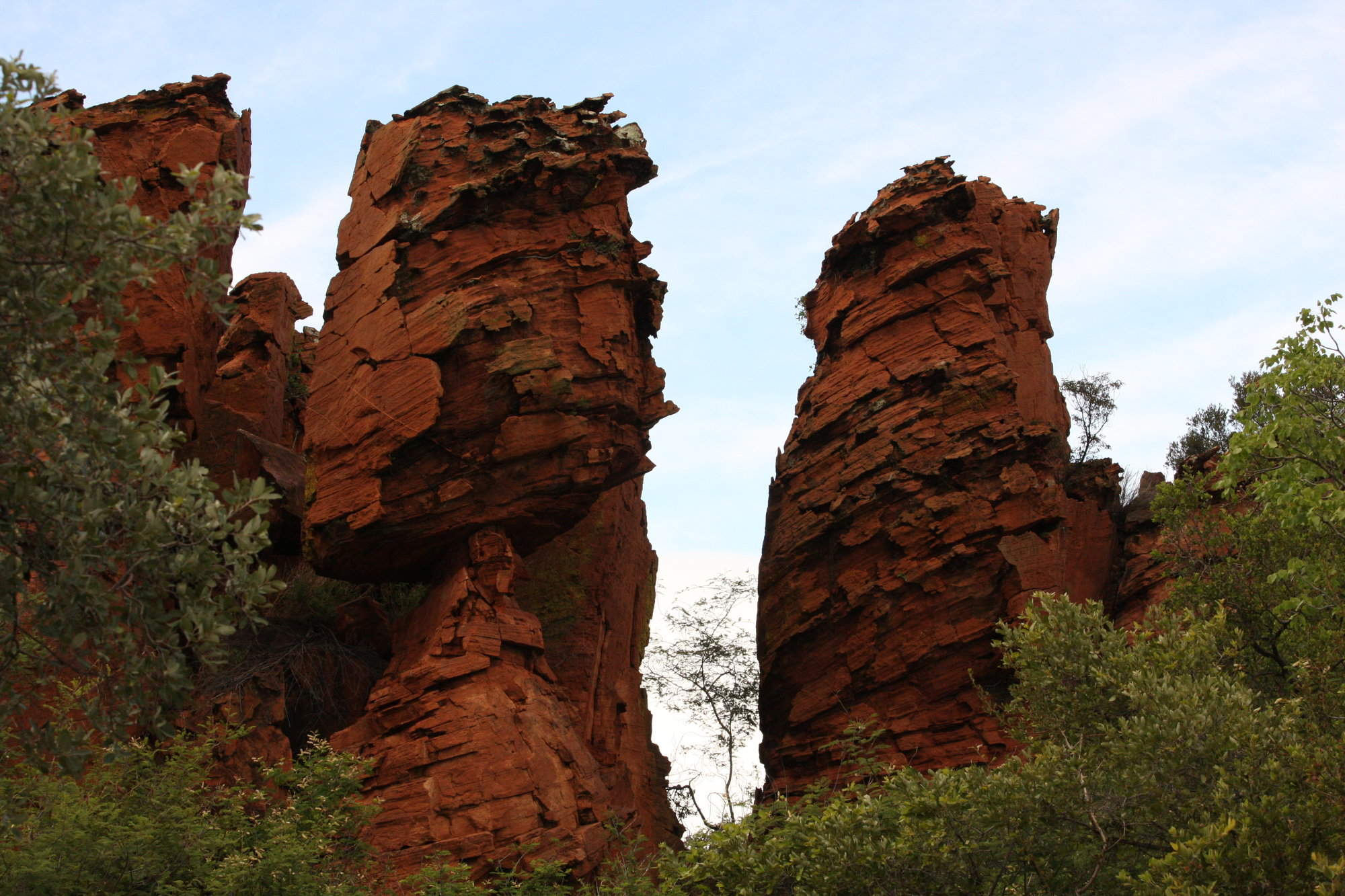Okonjima Plains Camp: Our full report
Okonjima Plains Camp is the most affordable place to stay within the 220km² private Okonjima Nature Reserve.
Designed to reflect its cattle-farming origins, it opened in 2014, replacing the first lodge on the farm, Okonjima Main Camp, which had been converted from the original Hanssen family farmhouse. Predators, most notably leopard, roam across 220km² of plains and rolling hills, their presence underpinned by the work of the AfriCat Foundation, which was set up to conserve and protect Namibia's wildlife, focusing primarily on carnivores.The newest of the accommodation options on the reserve, Okonjima Plains Camp opened in 2014, replacing Okonjima Main Camp, the original Hanssen family farmhouse that was converted into the first lodge on the farm. Plains Camp, along with its sister properties the Bush Suite and Bush Camp, is located within a 20km² fenced “wilderness” area of the Okonjima Reserve. While there are antelope, warthog and giraffe in this fenced area, most larger predators have been moved elsewhere in the reserve, so it is deemed safe for guests to walk around the lodge unescorted. This safe zone also makes Plains Camp a great option for those travelling with under 18s.
The focal point of Plains Camp is the enormous main area that houses the reception desk, bar and curio shop, and a large dining area and several sitting areas spread out over two levels. Rather aptly nicknamed The Barn, the building is indeed reminiscent of a farm barn, albeit quite a modern, industrial one with a polished concrete floor, very high metal roof and exposed beams and brickwork, and floor-to-ceiling glass windows across the entire front, facing the grassy plains. From the murals on the walls depicting life on a cattle farm, to the cattle-loading ramp near the main entrance and the swimming pool designed to look like a farm dam, Okonjima’s farming past is the main design influence here - we particularly liked the cooling “windmill” ceiling fans. In winter, warmth emanates from woodburners that are spaced between the homemade polished-metal dining tables and numerous sofas.
Because of its size, Plains Camp doesn't feel as cosy as its more exclusive sister lodges on the reserve – Okonjima Bush Camp, Okonjima Villa and Okonjima Bush Suite – and it may even seem a little “cold” at The newest of the accommodation options on the reserve, Okonjima Plains Camp, along with its more exclusive sister properties, Okonjima Bush Suite and Okonjima Bush Camp, is located within a 20km² fenced “wilderness” area of the private reserve. While there are antelope, warthog and giraffe in this fenced area, most larger predators have been moved elsewhere in the reserve, so it is deemed safe for guests to walk around the lodge unescorted. This safe zone also makes Plains Camp a great option for those travelling with under 18s.
The focal point of Plains Camp is the enormous main area that houses the reception desk, bar and curio shop, and a large dining area and several sitting areas spread out over two levels. Rather aptly nicknamed The Barn, the building is indeed reminiscent of a farm barn, albeit quite a modern, industrial one with a polished concrete floor, very high metal roof and exposed beams and brickwork, and floor-to-ceiling glass windows across the entire front, facing the grassy plains. From the murals on the walls depicting life on a cattle farm, to the cattle-loading ramp near the main entrance and the swimming pool designed to look like a farm dam, Okonjima's farming past is the main design influence here - we particularly liked the cooling “windmill” ceiling fans. In winter, warmth emanates from woodburners that are spaced between the homemade polished-metal dining tables and numerous sofas.
Because of its size, Plains Camp doesn't feel as cosy as its sister lodges on the reserve, and it may even seem a little “cold” at first. However, take some time to chat with a member of the team or to walk around, and we think you'll start to feel more in touch with the place, as we have on our visits – most recently in April 2024. In pride of place, pictures of smiling family and team members line the wall in the dining area, while opposite, on the lounge side, Hanssen family photographs of years gone by add a welcome personal touch.
Outside, the setting is completed by an alfresco sitting area and, to the side, a barbecue and a couple of pizza ovens. There is also a small pool, surrounded by manicured lawns dotted with sunloungers and shaded areas to relax out of the sun.
With a total of 24 rooms, Okonjima Plains Camp is larger than its predecessor, with two types of room: 14 Standard Rooms and 10 View Rooms, which are larger. Despite the names, both offer views out towards the plain in front of the camp. All are comfortable, but the View Rooms have a larger bedroom, bathroom and outside veranda than the Standard Rooms. In addition, a little more attention has been paid to their décor and they are spaced further apart for added privacy.
Nonetheless, all the rooms are spacious, and beautifully designed with light hues of blues and greens, and splashes of bright colours. The walls are decorated with painted wooden African artwork and photographs of Okonjima's carnivores; brightly handcrafted giraffe carvings stand tall around the room and woollen rugs and mats are scattered on the polished concrete floors.
The main bedroom area has huge windows, letting in plenty of light and affording great views of the plains from your bed. Two double beds, which can be pushed together to make one king-size bed, lie beneath two ceiling fans, while hot-water bottles are provided for cooler evenings. Behind the headboard are shelves and hanging space, and each room has a tea/coffee station, a small selection of books, a safe and a telephone to contact reception.
The bathroom is a good size and has twin washbasins, with large wall mirrors and a vanity area with a retro-style stool and a make-up/shaving mirror. There is also a mini fridge where you can keep bottled water and drinks. Off this is a separate toilet and at the other end of the bathroom is a large walk-in shower, with single shower heads in the Standard Rooms and twin shower heads in the new View Rooms.
For families, two of the View Rooms and four of the Standard Rooms are configured as adjoining units with an interleading door. Plains Camp has the most relaxed attitude towards families and children at Okonjima, accepting children as young as three years old, although parents still need to be aware of some restrictions to activities, in place for safety reasons.
Outside, each of the rooms has a private veranda with comfortable canvas chairs and a small table. Each also has its own shaded parking area, a useful addition as rooms furthest from the main area are quite a hike.
Activities at Plains Camp, as at its sister camps at Okonjima, are varied, but here, with the exception of the self-guided walking trails, all activities cost extra. They can be arranged and paid for at the camp.
Without doubt the main attraction of the Okonjima Reserve is the chance to track big cats and carnivores. Radio-tracking leopards from open-sided game-viewing vehicles is the main event (though you will see a range of other animals and birds on this activity too). A stay of one or two nights at Okonjima will usually give you the chance to see leopards, and much more, at close range, although even with the aid of radio collars, leopard sightings can never be guaranteed.
In addition to leopard tracking, other activities include:
- Nature Drives: There are over 40 mammal species on the reserve and many more birds. Guests will see many of these while out tracking leopard, or other species. If you stay more than a night or two you may choose to go out without using tracking telemetry and see what you can find.
- Pangolin Tracking: this activity has limited availability and is weather-dependent. Departing after dark, guests have the opportunity to track radio-tagged ground pangolin, following at a discreet distance on foot. Good footwear and a flashlight are required. Pangolins spend much of their time underground, so even with tracked individuals, sightings are not guaranteed.
- Rhino Tracking: Okonjima is home to a small population of southern white rhino that is constantly monitored by the reserve's anti-poaching team. On this activity, guests may often approach the rhino on foot.
- AfriCat Carnivore Care Centre: Visit some of the reserve's welfare animals, individuals that cannot be released into the wild. These animals help with education and provide an insight into the work of the AfriCat Foundation. After visiting the welfare animals you'll head to the information centre to learn about the history of Okonjima and their ongoing work.
- Night Drive: Many of Namibia's animals are exclusively nocturnal, so this activity offers the chance to head out into the bush after dinner to try and find species that you'd usually miss during the day.
- Self-guided Walking Trails: For those who'd like a break from bumping around in a vehicle and/or would like to stretch their legs, there are several well-marked walking trails within the fenced wilderness area. These offer the chance to look at the smaller things and spot some of the reserve's many bird species.
Guests who have checked out of the camp but want to leave later can spend their time relaxing by the pools, enjoying lunch or visiting the Carnivore Care Centre until they are ready to leave.
Our view
Okonjima Plains Camp has a relaxed, informal, and friendly atmosphere. It is an ideal base for those wanting to visit the AfriCat Foundation while staying in tasteful accommodation with all the amenities and facilities that go with a good-quality lodge but without a very high price tag. It also offers great photographic opportunities for leopard (plus some smaller creatures too). And as Okonjima is within easy reach of Windhoek Airport, this is an ideal destination for the end of your Namibian adventure.
Geographics
- Location
- Okonjima Nature Reserve, Namibia
- Ideal length of stay
- At least two nights is best to enjoy the reserve and its activities. However, if time is limited, a one-night stay should give you an idea of what the AfriCat Foundation does, and with luck you will see some cats.
- Directions
- Okonjima Plains Camp lies some 23km west of the B1, about 48km south of Otjiwarongo.
- Accessible by
- Self-drive or Fly-and-Transfer
Food & drink
- Usual board basis
- Half Board
- Food quality
- Although we didn't eat at Plains Camp on our most recent visit in May 2024, the food during a previous stay was of a good standard and dishes were nicely presented. With advanced notice we understand the camp can cater for most dietary requirements.
Before setting out on the early morning activity, guests are offered tea/coffee and muffins to keep you going until your return, when a full brunch is served. This is usually an array of cereals, bread, cheese and cold meat, fruit, yoghurts, and a full cooked breakfast of your choice, such as eggs, bacon, sausage, tomatoes, mushrooms, omelettes and pancakes.
A set-menu lunch is also available.
Dinner at Okonjima has always been a real treat for us. On our last stay, our three-course meal started with a tasty soup and freshly baked bread rolls still warm from the oven, followed by beef roulade with broccoli, carrots and spicy rice, and rounded off with a wonderful plate of poached pears with vanilla ice cream drizzled with red-wine syrup. Okonjima has a good selection of local and South Africa wines to complement their dinners. - Dining style
- Individual Tables
- Dining locations
- Indoor and Outdoor Dining
- Further dining info, including room service
- No
- Drinks included
- Tea and coffee are included. All other drinks are extra.
Special interests
- Birdwatching
- Okonjima boasts birdlife typical of Namibia's Central Highlands. The guided or self-guided walks pass by a variety of watering points, including dams, lakes and even bird-baths – making a lovely addition to a Namibian birdwatching break.
- See ideas for Birdwatching in Namibia
- Photography holidays
- For close-up shots of predators, especially leopard, Okonjima deserves to be high on the list for photography in Namibia. Allow at least two days to maximise your photographic chances, and do be aware that most of the big cats are collared.
- See ideas for Photography holidays in Namibia
- Wildlife safaris
- Visitors at Okonjima can usually view big cats at much closer quarters than is possible in most national parks. With most animals on the reserve habituated to humans, this is a good place to end a wildlife safari in Namibia.
- See ideas for Wildlife safaris in Namibia
Children
- Attitude towards children
- Children of all ages are welcome at Plains Camp, but for safety reasons, there are restrictions on the ages of children allowed on activities.
- Property’s age restrictions
- Well-behaved children aged six and over are allowed on activities conducted in a vehicle. Those between the ages of three and six may visit the Africat Carnivore Care Centre. For tracking wildlife on foot, the minimum age limit is normally at least 14 years.
- Special activities & services
- There are no special activities for young children
- Equipment
- Highchairs and cots are available on request. These should be arranged in advance.
- Generally recommended for children
- Okonjima's adoption of a more child-friendly approach makes it more suitable for children than it used to be. However, with strict age restrictions for activities, we think it's still most suitable – and likely to be more interesting – for children aged six and over.
- Notes
- Children must be under the constant supervisioin of their parents or guardians at all times. The pool is not fenced and despite a fence around what Okonjima term as the “safe zone”, there is some wildlife (warthogs, antelope, zebra, giraffe etc) in the area where Plains Camp is located.
Our travellers’ wildlife sightings from Okonjima Plains Camp
Since mid-2018, many of our travellers who stayed at Okonjima Plains Camp have kindly recorded their wildlife sightings and shared them with us. The results are below. Click an animal to see more, and here to see more on our methodology.

99% success

95% success

95% success

95% success

71% success

59% success

55% success

50% success

33% success

10% success

10% success

9% success
Communications
- Power supply notes
- There are plug points in each room for charging batteries and electronic equipment.
- Communications
- There is normally cellphone reception at Okonjima, and there is a central telephone in The Barn. The camp has WiFi in the main area, as well as a computer with internet access for guest use.
- TV & radio
- No
- Water supply
- Borehole
- Water supply notes
- All rooms have plumbed-in showers and hand basins, and flushing toilets.
Health & safety
- Malarial protection recommended
- No
- Medical care
- The nearest doctor is in Otjiwarongo, about 40 minutes' drive from Okonjima. In a medical emergency, the camp can arrange for travellers to be flown to Windhoek.
- Dangerous animals
- Moderate Risk
- Security measures
- The whole reserve is fenced and there are guards at the main entrance gate.
- Fire safety
- There are fire extinguishers in each room and in the central areas.
Activities
4WD Safari
Birdwatching
Cultural excursion
Mountain biking
Night drive
Private activities
Self-guided walking
Extras
- Disabled access
- On Request
- Laundry facilities
- Laundry can be done at an extra charge.
- Money
- Each room has a small safe for storing valuables. There are no currency-exchange facilities available.
- Accepted payment on location
- Okonjima accepts Visa or Mastercard credit or debit cards. Payments can also be made in cash with Namibian dollars and South African rand.
Other lodges in Okonjima Nature Reserve
Alternative places to stay in this same area.
